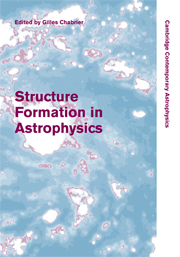Book contents
- Frontmatter
- Contents
- List of contributors
- Preface
- Part I Physical Processes and Numerical Methods Common to Structure Formations in Astrophysics
- 1 The physics of turbulence
- 2 The numerical simulation of turbulence
- 3 Numerical methods for radiation magnetohydrodynamics in astrophysics
- 4 The role of jets in the formation of planets, stars and galaxies
- 5 Advanced numerical methods in astrophysical fluid dynamics
- Part II Structure and Star Formation in the Primordial Universe
- Part III Contemporary Star and Brown Dwarf Formation
- Part IV Protoplanetary Disks and Planet Formation
- Part V Summary
2 - The numerical simulation of turbulence
Published online by Cambridge University Press: 11 August 2009
- Frontmatter
- Contents
- List of contributors
- Preface
- Part I Physical Processes and Numerical Methods Common to Structure Formations in Astrophysics
- 1 The physics of turbulence
- 2 The numerical simulation of turbulence
- 3 Numerical methods for radiation magnetohydrodynamics in astrophysics
- 4 The role of jets in the formation of planets, stars and galaxies
- 5 Advanced numerical methods in astrophysical fluid dynamics
- Part II Structure and Star Formation in the Primordial Universe
- Part III Contemporary Star and Brown Dwarf Formation
- Part IV Protoplanetary Disks and Planet Formation
- Part V Summary
Summary
Turbulence is a remarkable subject in physics. The underlying equations, which are in their simplest formulation the Euler equations, were published 250 years ago (Euler 1757). Yet a theoretical grasp of the phenomenology emerging from these equations had not been achieved before the mid-twentieth century, when Heisenberg (1923) and Kolmogorov (1941) obtained their first analytical results. Eventually, it took the capabilities of modern supercomputers to obtain a full appreciation of the complexity that is inherent to the Euler equations. Astrophysics is now at the very frontier of numerical turbulence modelling. Among the additional ingredients for making turbulence in astrophysics even more complex are supersonic flow, self-gravity, magnetic fields and radiation transport. In contrast, terrestrial turbulence is mostly incompressible or only weakly compressible. External gravity is, of course, an issue in the computation of atmospheric processes on Earth. Self-gravity, however, is only encountered on large, astrophysical scales. The dynamics of turbulent plasma has met vivid attention in research related to nuclear fusion reactors but, otherwise, is not encountered under terrestrial conditions.
In this chapter, I give an overview of the various approaches towards the numerical modelling of turbulence, particularly, in the interstellar medium (ISM). The discussion is placed in a physical context, i.e. computational problems are motivated from basic physical considerations. Presenting selected examples for solutions to these problems, I introduce the basic ideas of the most commonly used numerical methods. For detailed methodological accounts, the reader is invited to follow the references.
- Type
- Chapter
- Information
- Structure Formation in Astrophysics , pp. 20 - 36Publisher: Cambridge University PressPrint publication year: 2009
- 2
- Cited by



